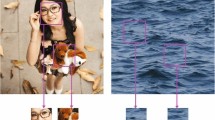Abstract
In this paper, we present a novel texture-based visualizing algorithm. This algorithm can be used as a robust and effective descriptor based on view-dependent information-theoretic statistical analysis of flow data. We calculate local entropy values to measure the distinct feature structures in the underlying field. Volume rendering is used to visualize the extracted flow patterns automatically. Due to the high computational expense, texture construction and rendering skip all empty and unimportant blocks. And an efficient GPU implementation is integrated together for high interactive frame rates. We show the key components of our approach with detailed analysis, and demonstrate that our method can visualize 2D and 3D flow data effectively.
Graphical abstract







Similar content being viewed by others
References
Bordoloi UD, Shen HW (2005) View selection for volume rendering. In: Proceedings of IEEE Visualization Conference’05, Minneapolis, MN, USA, October 2005, pp 487–494
Crawfis R, Max N (1992) Direct volume visualization of three-dimensional vector fields. In: Proceedings of the 1992 Workshop Volume Visualization, pp 55–60
Daniel R (2009) An algorithm for computing Voronoi diagrams of general generators in general normed spaces. In: Proceedings of the sixth International Symposium on Voronoi Diagrams in science and engineering (ISVD 2009), pp 144–152
Daniel R (2011) The geometric stability of Voronoi diagrams with respect to small changes of the sites, Full version: arXiv 1103.4125 (2011). Extended abstract in Proceedings of the 27th Annual ACM Symposium on Computational Geometry (SoCG 2011), pp 254–263
Falk M, Weiskopf D (2008) Output-sensitive 3d line integral convolution. IEEE Trans Vis Comput Graph 14(4):820–834
Helgeland A, Andreassen O (2004) Visualization of vector fields using seed LIC and volume rendering. IEEE Trans Vis Comput Graph 10(6):673–682
Interrante V (1997) Illustrating surface shape in volume data via principal direction-driven 3d line integral convolution. In: Computer Graphics Proceedings, Annual Conference Series, Aug 1997, pp 109–116
Interrante V, Grosch C (1998) Visualizing 3d flow. IEEE Comput Graph Appl 18(4):49–53
Jänicke H, Wiebel A, Scheuermann G, Kollmann W (2007) Multifield visualization using local statistical complexity. IEEE Trans Vis Comput Graph 13(6):1384–1391
Jänicke H, Böttinger M, Tricoche X, Scheuermann G (2008) Automatic detection and visualization of distinctive structures in 3d unsteady multi-fields. Comput Graph Forum 27(3):767–774
Jänicke H, Scheuermann G (2010) Visual analysis of flow features using information theory. IEEE Trans Vis Comput Graph 30(1):40–49
Jobard B, Lefer W (1997) Creating evenly-spaced streamlines of arbitrary density. In: Proceedings of the Eurographics Workshop Visualization in Scientific Computing, pp 45–55
Li GS, Bordoloi U, Shen HW (2003) Chameleon: an interactive texture-based rendering framework for visualizing three-dimensional vector fields. In: Proceedings of the IEEE Visualization, pp 241–248
Liu Z, Moorhead RJ (2008) II. Interactive view-driven evenly spaced streamline placement. In: Proceedings of the IS&T/SPIE Conference on Visualization and Data Analysis (VDA ’08), pp 1–12
Lu DY, Zhu DM, Wang ZQ (2016) Efficient level of detail for texture-based flow visualization. Comput Animat Virtual Worlds 27(2):123–140
Mao X, Kikukawa M, Fujita N, Imamiya A (1997) Line integral convolution for 3d surfaces. In: EG Workshop on Visualization’97, pp 57–70
Max N (1995) Optical models for direct volume rendering. IEEE Trans Vis Comput Graph 1(2):99–108
Post FH, Vrolijk B, Hauser H, Laramee RS, Doleisch H (2003) The state of the art in flow visualisation: feature extraction and tracking. Comput Graph Forum 22(4):775–792
Reza FM (1961, 1994) An introduction to information theory. Dover Publications, Inc., New York. ISBN 0-486-68210-2
Rezk-Salama C, Hastreiter P, Teitzel C, Ertl T (1999) Interactive exploration of volume line integral convolution based on 3d-texture mapping. In: Proceedings of the IEEE Visualization, pp 233–240
Shalizi CR, Haslinger R, Rouquier J-B, Klinkner KL, Moore C (2006) Automatic filters for the detection of coherent structure in spatiotemporal systems. Phys Rev E 73:036104
Shannon CE (1948) A mathematical theory of communication. Bell Syst Tech J 27:379–423
Shen HW, Li GS, Bordoloi U (2004) Interactive visualization of three-dimensional vector fields with flexible appearance control. IEEE Trans Vis Comput Graph 10(4):434–445
Takahashi S, Fujishiro I, Takeshima Y, Nishita T (2005) A feature-driven approach to locating optimal viewpoints for volume visualization. In: Proceedings of IEEE Visualization Conference’05, Minneapolis, MN, USA, October 2005, pp 495–502
Verma V, Kao DT, Pang A (2000) A flow-guided streamline seeding strategy. In: Vis’00: Proceedings of the IEEE Visualization 2000, pp 163–170
Wang C, Yu H, Ma KL (2008) Importance-driven time-varying data visualization. IEEE Trans Vis Comput Graph. 14(6):1547–1554
Wang C, Shen HW (2006) LOD map—a visual interface for navigating multiresolution volume visualization. IEEE Trans Vis Comput Graph 12(5):1029–1036
Weiskopf D, Ertl T (2004) A hybrid physical/device-space approach for spatio-temporally coherent interactive texture advection on curved surfaces. In: GI’04 Proceedings of Graphics Interface, pp 263–270
Xu L, Lee TY, Shen HW (2010) An information-theoretic framework for flow visualization. IEEE Trans Vis Comput Graph 16(6):1216–1224
Ye X, Kao DT, Pang A (2005) Strategy for seeding 3d streamlines. In: Vis ’05: Proceedings of the IEEE Visualization 2005, pp 471–478
Acknowledgments
The authors would like to thank the reviewers for their valuable comments. Thanks to Prof. Roger Crawfis from Ohio State University for kindly providing the Tornado data set, and thanks to Wang Z.F. from the Institute of Atmospheric Physics in Chinese Academy of Sciences for providing the atmospheric pollution data set in Pearl River Delta region. This work is supported and funded by the National Natural Science Foundation of China (No. 61173067, No. 61272322, No. 61303157, No. 61379085).
Author information
Authors and Affiliations
Corresponding author
Rights and permissions
About this article
Cite this article
Lu, D. Information-theoretic exploration for texture-based visualization. J Vis 20, 393–404 (2017). https://doi.org/10.1007/s12650-016-0376-4
Received:
Revised:
Accepted:
Published:
Issue Date:
DOI: https://doi.org/10.1007/s12650-016-0376-4




